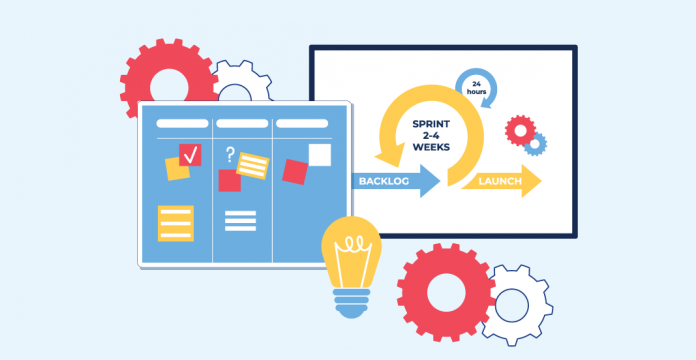
Today, enterprises are more and more complex, while they still need to generate value to customers and stakeholders, they also need solid processes and frameworks to improve internal efficiency and performance, so they can stay in business and keep moving forward. And when it comes to Agile, it is just not about software delivery. Today, Agile is a concern for the C-suite as it is about driving change from top to bottom within the organization. Implementing Agile for day-to-day operations is all about uncovering better ways to achieve the best possible result.
So, understanding how Agile can be implemented within the organization needs a certain context. Enterprises need to find a way that permeates the message of Agile that is impactful, easily understandable, and versatile enough to scale across departments. Agile implementation for day-to-day operations within the enterprise needs buy-in from the top and simplifying the landscape around the framework.

Invensis Learning, a premier training, and certification organization that provides widely-recognized Agile Project Management certification courses decided to do a quick survey on simplifying Agile implementation for day-to-day operations. As a training and certification provider, we wanted to clearly understand firsthand from Agile Practitioners how a complex approach like Agile which in the majority is used for software development can be implemented in other areas within the organization.
So, we created geography-specific research on the subject and approached Agile Practitioners from the US, UK, and Australia to begin with, and the response was overwhelming. These excerpts are not compiled by any in-house writer; these are from the leading industry experts with 10-15+ years of experience in their respective domains. So, let’s understand simplifying Agile Implementation for day-to-day operations.
1. Jose Francisco Valiente, Agile Project Manager, IBM, Greater Boston Area, US
What are companies doing with the Agile process, differently, to simplify their operations?
Value Delivery Focus: Companies understand the idea of delivering less, but delivering smaller projects, or parts of a project, more often by breaking a large task down into smaller deliverables. Breaking down these tasks into MVPs (Minimum Viable Products) it allows Agile teams to iterate and deliver smaller pieces of value that allow the users to achieve their goals at an early stage and for improvement to features as they progress.
Clarity on the Deliverables: Even with an unclear development path, organizations are willing to start work faster and learn on the go and work with the users to share their work and validate the ideas and experiences delivered. Using practices such as the wall of work, stand-ups, planning, showcases, and retrospectives organizations keep their effort on the goals while the teams remain focused and motivated.
User Centricity: An Agile Process allows us to understand our customer’s needs and requirements and implement those experiences for them. An example of this would be “Methodologies as Design Thinking” which can be perfectly combined to help companies identify users, build their profiles, and design the right work for them.
Does it Make Sense? Many times, we find ourselves immersed in a lot of work that we don’t know or understand its relevance to the business. Questioning why we are doing things and aligning these to the Company’s Mission and Vision can help us define where we need to invest our time.
Companies looking to simplify their processes need to understand the balance between doing the right work and doing the work right is fundamental for their business to thrive. Having an Agile Mindset is one way that a business, company, client, or customer can achieve that goal.
2. Jo Hawkins, Director, JKBK Consultancy, Perth, UK
I currently have the great pleasure of working as a consultant to a UK Private Sector water utility company, with the objective of ‘standing up’ their agile approach to delivering change. The infrastructure is complex and the change requirements are never-ending, and as far as agile goes, they are at ground zero.
Simplification has been key over these 3 initial months. My focus has been on:
- How to bring people on board without blinding them with the science and ‘Agile speak’ that, let’s face it, doesn’t mean that much to anyone without a modicum of exposure to agile
- How to role-model Agile behaviors and best practices without alienating those around me
- How to prove Agile works and delivers on its promises.
The key for me has been to bring out my inner hippy and practice mindfulness in relation to the Agile manifesto. After every stand-up/meeting/work-related activity and at the end of the day I check myself against the following:
- Has the conversation we have had been the true focus of my attention?
- Have I listened to understand?
- Am I confident that the action we have agreed is the right one?
- Are my customers displaying confidence in the development team’s ability to deliver?
- Is the development team displaying confidence in their ability to deliver?
- Are both my customers and my development team constantly talking about the shippable products, with or without me?
- Have I always been present in the moment?
- Are we, as a collective, responding positively to and being accepting of ‘change to the change’?
- Are we testing, testing, testing?
- I temperature check the development team and myself constantly around how we are feeling – both physically, mentally, and emotionally – a Scrum retrospective is far too late for that – are we smiling, have we laughed, are we eating sensibly and getting exercise – there are a thousand ways you can do that without getting out the nurse’s clipboard.
- I temperature check my customers constantly – did that meeting work for you/ is the team delivering/ how do you feel about the test results/ did we respond quickly enough/ are you smiling and not grimacing at me/ are you asking for more?
It is early days, and I can’t possibly attest to how the company will adopt Agile long-term. What I can say is that I have meaningful conversations with my customers and my team without getting into the ‘Agile speak’ (as much as I love it); I am flexing across the Agile disciplines as best fits each user story without it becoming a drama (they don’t really need to know if we’re all Scrum, XP, Kanban or DSDM, etc. about things): and the development team are happy and loving it.
By the way, there are many reflective moments when I realized I got it all wrong. The beauty of tomorrow is that it’s another day so take the Kaizen moment, apply it and move on.
3. Andrew Phillips, Senior Agile Project Manager, Bell Integration, Bristol, UK
There are several things that need to be taken care of when using Agile. Apart from the obvious setting up a backlog and having a product manager that has intimate knowledge of what you are trying to create.
First, you need more discipline not less, and must keep a log of engineer and business decisions linked back to the original business case. Things can move fast in Agile, and if you don’t track what the original business was, it is easy to lose your way, delivering some value but missing one of the essential objectives. I’ve seen it done on numerous occasions, and companies take on Agile and throw away good management practice, delivering a project which misses an essential part and leaves them in deep trouble. Agile takes more effort not less but can provide great value in an uncertain development.
One of the other misnomers about Agile is what can change. Top-level managers seem to miss that you need a stable development team. The premise is Agile so everything can change is applied across the enterprise. The approach is Agile, but you need the same level of effort across the sprints to be able to measure throughput. So stealing developers back to do an urgent fault triage or having a constant churn on the team is going to make it very hard to estimate finish times. I am sure no one here would do this, but having a multifunctional team delivering an agile project makes it difficult to estimate and drive forward. By multifunction, I mean one that does agile development and second-line support, etc. Then you have other effects taking the resource, and the scrum master may not be authorized to hold these off.
Agile is really about making short goals clear and keeping the justification meetings to a minimum, but it’s not less effort and fewer meetings. It’s more meetings, and holding a firm on a resource team and being really careful you don’t dump something out of the backlog that is business critical after all! Above all Agile is a tool to get the best out of your people, sometimes it’s not the be-all and end-all. People deliver stuff, not processes.
4. Tom Taylor, Agile Project Manager, Foundation Medicine, Greater Boston Area, US
The Agile Manifesto itself gives guidance for daily operational agility. The only modification needed would be a shift from the statement “working software” to “working solutions” or to “value delivery.” Agility at its core leverages empirical focus via the inspect-adapt-be transparent model. For good measures throw in:
- Frequent feedback loops – with customers, users, within and between teams
- Willingness to learn
- Dedication to continuous (even if subtle) improvement
- The relentless pursuit of removing barriers
- Empowering both people and teams (and stop using the term “resources,” please)
- Psychological safety
Also, don’t conflate “Agile” with “Scrum”; but break the mindset that agile is only at the software team level. Definitely borrow from the Scrum values of Respect, Openness, Focus, and Courage. Don’t impose but create the scaffolding for organizational culture. Form appropriate teams at appropriate levels with strong collaboration between them. At the risk of Agile-geekery, look at the Cynefin model and determine which domain you sit in and how you best can respond in a situational manner.
Contributed By:
Jose Francisco Valiente, Agile Project Manager, IBM, Greater Boston Area, US
He is an experienced Project Manager who has worked on a range of large and complex projects in multiple industries and countries. He has undertaken lead business and technical roles, managing teams with highly talented individuals, and delivering value immediately for the organizations he has collaborated with.
He has a BS in Industrial Engineering from ITESO University (Mexico) and an MBA by Eseune Business School (Spain). He is certified as PMP® and PMI-ACP® by the Project Management Institute, as a Senior Project Manager by IBM, and recently finished his Executive Certificate in Leadership and Management by the Massachusetts Institute of Technology (MIT). You can follow him on Twitter at @jfvaliente
Jo Hawkins, Director, JKBK Consultancy, Perth, UK
I am the Company Director of JBKB Consultancy Ltd., currently contracted to Business Stream as the Agile Project Manager to stand up their agile approach to delivering change. I am an ex-teacher who moved into Financial Services just over 28 years ago and have held a number of operational and non-operational roles across many sectors.
As a Project Manager, I realized that I had been, by instinct, practicing agile when I came across and read the work of Jeff Sutherland. I am totally dedicated to progressing the agile agenda at any and every opportunity. Many thanks for this one.
Andrew Phillips, Senior Agile Project Manager, Bell Integration, Bristol, UK
He is a skilled senior executive with extensive experience in driving digital transformation. Able to work in both traditional and Agile environments with a proven track record in delivering complex critical projects and programs, including accreditation of secure systems for the MOD, telecommunications systems, VOIP, and distributed architecture, cloud, and Datacentre transitions. He has successfully managed international projects in Germany, France, Italy, Belgium, and large distributed systems with many critical 24/7 systems including AirWatch migration programs.
Tom Taylor, Agile Project Manager, Foundation Medicine, Greater Boston Area, US
Focused on understanding customer needs being a Project Manager, Tom was drawn to an Agile way of thinking before knowing of Scrum or the Agile Manifesto. Working closely with customers, understanding the problem to be solved, and figuring out ways to deliver value incrementally were and remain his motivators.
With interests like Tai Chi and Stand-up Paddleboarding, Tom has always been attracted to concepts of flow and balance. He applies these interests directly as an agilist and fosters organizational excellence wherever he works. Reflecting his broad Agile thinking and continuous learner mindset, Tom holds a diverse range of Agile certifications.
About Invensis Learning
Invensis Learning is a leading training and professional development solutions, provider. We deliver globally-recognized training and certifications to individuals and enterprises to aid key business transformations and help to stay relevant by closing skill gaps and cultivating an environment that fosters continuous learning. We have trained 20000+ professionals over a wide portfolio of 50+ training and certification courses. We provide training and certification courses for categories such as Agile Certification Courses, ITSM Certification Courses, Project Management Certification Courses, Quality Management, IT Governance Certification Courses, DevOps Certification Courses, and Cloud that addresses the immediate and future needs of business evolution and technological relevance.














